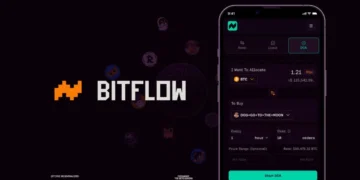Bitcoin (BTC) is typically less volatile than alternative cryptocurrencies (altcoins), but this week presented an unusual scenario. BTC took a bigger hit than smaller tokens, leading to a significant drop in its market dominance. This event paints a compelling picture of the selling pressure triggered by the upcoming repayments to the victims of the 2014 Mt. Gox exchange hack.
Bitcoin’s Market Dominance Drops
BTC’s dominance, or its share of the total cryptocurrency market value, fell by 1.8% to 54.34%, marking the largest single-day percentage drop since January 12, according to TradingView. In essence, investors likely pulled money out of Bitcoin faster than from its peers. The cryptocurrency’s price fell nearly 5%, reaching lows below $59,000 at one point, as reported by CoinDesk.
With Mt Gox, German coins, ETF selling on the horizon, I do not believe that support levels and ranges will hold
NVDA looking like a local top
The only buyers seem to be leverage and short term traders knife catching
These moves typically result in a multi billion dollar… https://t.co/4t70LPP25b
— Andrew Kang (@Rewkang) June 24, 2024
The Mt. Gox Factor
The sell-off was not without reason. News that the defunct crypto exchange Mt. Gox plans to distribute 140,000 BTC to hack victims in July heightened concerns that recipients might sell once they receive their payments, potentially flooding the market with excess supply. This added to the mounting pressures since June 7 from faster miner sales and outflows from spot exchange-traded funds (ETFs).
Market Reactions
Fears of mass sell-offs drove demand for short-term BTC put options on the Deribit exchange, according to data tracked by Amberdata. Put options provide protection against price drops in the underlying asset. The seven-day and one-month call-put skews, indicating what traders are willing to pay for asymmetric upside or downside exposure over a week and a month, have turned negative, signaling renewed demand for put options.
Some See Potential for Measured Selling
Some observers, however, say the actual selling pressure from Mt. Gox repayments may be more measured.
“The exact amount of Mt. Gox funds to be distributed in July is unspecified, but it’s part of a broader repayment plan that includes 142,000 Bitcoin and 143,000 Bitcoin Cash, as well as fiat currency totaling 69 billion Japanese yen ($432 million),” noted financial firm Tagus Capital. “However, Mt. Gox creditors may hold onto their bitcoin rather than sell, as they are long-term investors who have resisted previous dollar settlement offers and may face capital gains taxes on sales,” the firm said.
Time Will Tell on Mt. Gox Impact
Only time will tell how the Mt. Gox repayments will ultimately impact the bitcoin market. In the short term, the fear of increased supply is driving sell-off sentiment. However, the long-term impact may be less severe than some anticipate, as the market absorbs the additional supply and long-term holders hold onto their coins. Investors will be closely watching the behavior of Mt. Gox creditors and broader market dynamics in the coming weeks and months.
Take control of your financial future. Visit Crypto Wealth Academy now and join the crypto revolution!
Conclusion
The market’s reaction to the upcoming Mt. Gox repayments underscores the delicate balance of supply and demand in the cryptocurrency space. While short-term volatility may ensue, the long-term outlook for Bitcoin remains influenced by a myriad of factors, including investor sentiment and regulatory developments. As the crypto world braces for the distribution of these significant holdings, all eyes will be on how the market absorbs this influx and the subsequent impact on Bitcoin’s price and dominance.
FAQs
What caused the recent decline in Bitcoin’s market dominance?
The decline was primarily triggered by news of the upcoming distribution of 140,000 BTC to victims of the 2014 Mt. Gox exchange hack, leading to concerns about a potential market oversupply.
How much did Bitcoin’s dominance drop recently?
Bitcoin’s market dominance dropped by 1.8% to 54.34%, marking the largest single-day percentage decline since January 12.
What is the significance of the Mt. Gox repayments?
The repayments are significant because they could lead to a large influx of Bitcoin into the market, potentially causing further price drops if recipients decide to sell their BTC.
How did the market react to the Mt. Gox repayment news?
The market reacted with increased demand for short-term BTC put options, indicating a desire for protection against potential price drops.
Will all Mt. Gox creditors sell their Bitcoin?
Not necessarily. Some observers believe that many creditors may choose to hold onto their Bitcoin, as they are long-term investors who have resisted previous payout offers in dollars.
What other factors contributed to Bitcoin’s recent price drop?
Other contributing factors include faster sales by miners and outflows from spot exchange-traded funds (ETFs).
Disclaimer: The information provided in this article is for educational and informational purposes only and should not be construed as financial or investment advice. Cryptocurrency investments are highly volatile and involve significant risk. Always do your own research and consult with a qualified financial advisor before making any investment decisions. The author and publisher are not responsible for any losses or gains that may result from the use of this information. The views expressed in this article are those of the author and do not necessarily reflect the official policy or position of any other agency, organization, employer, or company.
Follow us on our social networks and keep up to date with everything that happens in the Metaverse!
Twitter LinkedinFacebookTelegramInstagramGoogle NewsAmazon Store











































